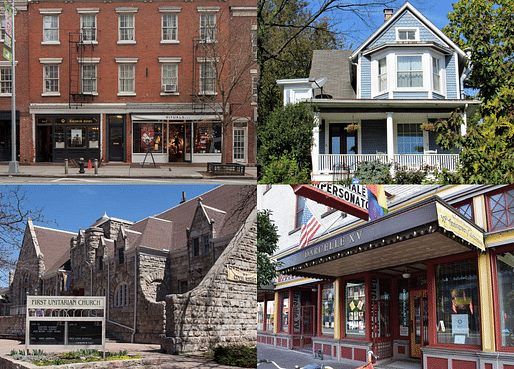

Preserving spaces are integral to maintaining America's gay communities and keeping the memory of their members' hard work in establishing physical sites of resistance in the face of legal repression, violence, and generational intolerance. Terms like "Gay power" convey the desire for visibility in those spaces that have evolved due to their hard-fought existence. Today they serve as a rallying cry for different scholarly interventions initiated to protect the important story of queer history in the United States.
In honor of the slate of Pride celebrations taking place in June, the National Trust for Historic Preservation continues to expand on the documentary research of these sites. Thanks to the National Park Service's influential 2016 Theme Study that identified several new locations for nomination to join the group's two official heritage designations, four new sites have been added to the list since its original publication.
In an update published by the Trust this week, board chair of the Hampton, Virginia-based Rainbow Heritage Network, Jeffrey A. "Free" Harris, described in detail the need for including each of the four sites, which he says "represent the diversity that exists within the LGBTQ community overall." This latest series of historical sites join the historic Stonewall Inn on the National Register, which was added in 1999.
“Historically, those historic places have been allowed to exist in communities that often have been neglected, forgotten, or not considered 'desirable.' And, as we know within historic preservation, neighborhood change can visit cities and towns, and that change often comes for those more marginalized communities,” Harris explains. “There has been a great deal of loss among LGBTQ historic places, and the scholarship that we have often showcases what once was. Yet, one of the best aspects of the scholarship that has been produced is that places that have not been lost will have chances at survival, and possible preservation/adaptive re-use.”
Below is the list of four newly added historic sites contextualized by Harris since the publication of the Theme Study.
Lorraine Hansberry Residence, New York City (Listed in 2021)
Description: Hansberry, a playwright and activist wrote the play 'A Raisin in the Sun' while she lived in this residence. She also was an activist in the Civil Rights Movement, working with a coalition of African American artists to advance that cause.
The Slowe-Burrill House, Washington, D.C. (Listed in 2020)
Description: Lucy Diggs Slowe was the Dean of Women at Howard University, and a leader in the education of African American women in the early 20th century, and Mary Burrill was a teacher at Paul Laurence Dunbar High School, one of the best high schools in the nation during its time.
First Unitary Society of Denver, Denver, Colorado (Listed in 2017)
Description: The church was the site of the first same sex wedding ceremony in Colorado in 1975. It also was the home, briefly, of the Metropolitan Community Church of the Rockies (a denomination that is affirming of the LGBTQ community).
Darcelle XV, Portland, Oregon (Listed in 2021)
Description: The eponymously named drag club is one of oldest continuously running clubs with the owner (Walter Cole/Darcelle) still performing. The club opened in 1967.
Harris added, "I am confident that there will be continued growth in the number of designated historic places associated with the LGBTQ community in the years to come. The momentum is there."
More details on the LGBTQ Heritage Theme Study can be read here.
No Comments
Block this user
Are you sure you want to block this user and hide all related comments throughout the site?
Archinect
This is your first comment on Archinect. Your comment will be visible once approved.